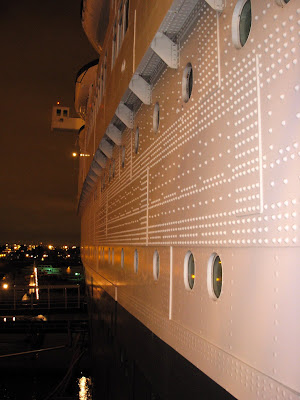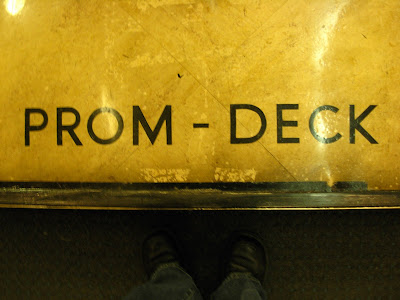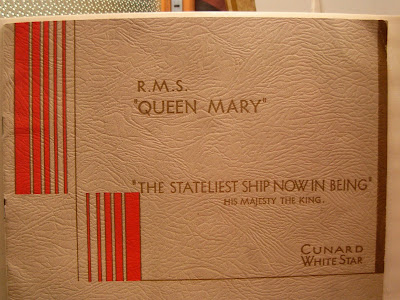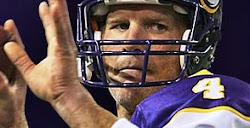I got an unexpected phone call from my fishing buddy Dave, telling me he and his wife, Barb, would be in Long Beach golfing and visitng their son, Lance (they had emailed me in advance but didn’t receive it). I met them for drinks at their hotel and then we had dinner and walked over to tour the RMS Queen Mary.
 The Queen Mary sailed the North Atlantic Ocean from 1936 to 1967 for the Cunard Line (then Cunard White Star Line). Built by John Brown and Company, Clydebank, Scotland, she was designed to be the first of Cunard’s planned two-ship weekly express service from Southampton to Cherbourg to New York, in answer to the mainland European superliners of the late twenties and early thirties.
The Queen Mary sailed the North Atlantic Ocean from 1936 to 1967 for the Cunard Line (then Cunard White Star Line). Built by John Brown and Company, Clydebank, Scotland, she was designed to be the first of Cunard’s planned two-ship weekly express service from Southampton to Cherbourg to New York, in answer to the mainland European superliners of the late twenties and early thirties.
In the foreground of the above photo is the Soviet sub, the Scorpion, the diesel electric attack submarine, known to NATO as the Foxtrot Class, was one of the most successful class of submarine ever in service to the Soviet Navy. Hold up - I'm getting ahead of myself. If you're interested in more history on the Queen Mary, watch Robert Stack on Unsolved Mysteries. There are a few more pictures so if you’d like to continue, click on READ MORE. Plus you wanna see the ghost picture, don’t you? And by the way, this is NOT an April Fool's joke. There was NO MANIPULATION of the camera or photo involved. Whatever's there appeared on it's own. Don't be scared.
The Scorpion was completed and commissioned into the Soviet Navy in 1974. For the next 20 years, the missions undertaken by Scorpion are shrouded in secrecy and remain so to this day, still classified TOP SECRET by the new Navy of the Russian Federation. In 1994, Scorpion was decommissioned and has been berthed in Long Beach since 1998.
 Got sidetracked on that commie sub that we didn’t even tour. Interesting information though. Anyway, the Queen Mary and her slightly larger and younger running mate RMS Queen Elizabeth commenced there two-ship service of passengers after their release from World War II troop transport duties and continued it for two decades until Queen Mary’s retirement in 1967. The ship is listed on the National Register of Historic Places, and is permanently berthed in Long Beach, California serving as a museum ship and hotel. The Queen Mary celebrated the 70th anniversary of her launch in both Clydebank and in Long Beach during 2004, and the 70th anniversary of her maiden voyage in 2006.
Got sidetracked on that commie sub that we didn’t even tour. Interesting information though. Anyway, the Queen Mary and her slightly larger and younger running mate RMS Queen Elizabeth commenced there two-ship service of passengers after their release from World War II troop transport duties and continued it for two decades until Queen Mary’s retirement in 1967. The ship is listed on the National Register of Historic Places, and is permanently berthed in Long Beach, California serving as a museum ship and hotel. The Queen Mary celebrated the 70th anniversary of her launch in both Clydebank and in Long Beach during 2004, and the 70th anniversary of her maiden voyage in 2006.
 The Queen Mary measures 1,019.5 ft. in length. That’s around 3 ½ football fields. The Titanic was 882.9 ft. and the QM out measured the Titanic in every possible way, making her the largest passenger ship for her time.
The Queen Mary measures 1,019.5 ft. in length. That’s around 3 ½ football fields. The Titanic was 882.9 ft. and the QM out measured the Titanic in every possible way, making her the largest passenger ship for her time.
 A map that charts the course of the QM as she sails across the Atlantic.
A map that charts the course of the QM as she sails across the Atlantic.
 There are a number of floor-to-ceiling, black-and-white photographs of some of the celebrities who sailed on the ship (I just saw this one), including Buster Keaton (pictured above), Bing Crosby, Charlie Chaplin and Elizabeth Taylor.
There are a number of floor-to-ceiling, black-and-white photographs of some of the celebrities who sailed on the ship (I just saw this one), including Buster Keaton (pictured above), Bing Crosby, Charlie Chaplin and Elizabeth Taylor.
 The QM transporting U.S. troops to NYC in 1945.
The QM transporting U.S. troops to NYC in 1945.
 One of the dining rooms on board.
One of the dining rooms on board.
 The teak flooring on the deck of the ship is original.
The teak flooring on the deck of the ship is original.
 Two of the three - whatever you call them. Steam thingys. Smoke stacks - that’s it!
Two of the three - whatever you call them. Steam thingys. Smoke stacks - that’s it!
 Original marking for Promenade Deck. Where’s Gopher and Captain Stuebing??? Ha ha, ha ha, haaaaaaaaaaaaaaaaa. That’s a Love Boat reference, people. COME ON!
Original marking for Promenade Deck. Where’s Gopher and Captain Stuebing??? Ha ha, ha ha, haaaaaaaaaaaaaaaaa. That’s a Love Boat reference, people. COME ON!
 My picture is not cock-eyed. The door was framed to jive with the sheer, sloping, slant -whatever of the ship. What do you call that?
My picture is not cock-eyed. The door was framed to jive with the sheer, sloping, slant -whatever of the ship. What do you call that?
 First class room corridor. You can tell better when you’re actually standing there how the hallway dips down and then back up. Again this is to take into account the bowing of the ship. Hmm. I don't see a ghost in this picture. Do you?
First class room corridor. You can tell better when you’re actually standing there how the hallway dips down and then back up. Again this is to take into account the bowing of the ship. Hmm. I don't see a ghost in this picture. Do you?
 Kenneth Shoesmith's painting, the Madonna of the Atlantic. Note that the painting originally showed Christ unclothed. Cunard asked Shoesmith to add a sash for decency’s sake. The QM was built during the time that Art Deco movement was flourishing. You may have already seen examples of some of this in previous pictures. The structure of art deco is based on mathematical geometric shapes. It was widely considered to be an eclectic form of elegant and stylish modernism, being influenced by a variety of sources.
Kenneth Shoesmith's painting, the Madonna of the Atlantic. Note that the painting originally showed Christ unclothed. Cunard asked Shoesmith to add a sash for decency’s sake. The QM was built during the time that Art Deco movement was flourishing. You may have already seen examples of some of this in previous pictures. The structure of art deco is based on mathematical geometric shapes. It was widely considered to be an eclectic form of elegant and stylish modernism, being influenced by a variety of sources.
 Among them were the, so called, “primitive” arts of Africa, Ancient Egypt, and Aztec Mexico, as well as Machine Age or streamline technology such as modern aviation, electric lighting, the radio, the ocean liner and the skyscraper. These design influences were expressed in fractionated, crystalline, faceted forms of decorative Cubism and Futurism, in Fauvism’s palette. Other popular themes in art deco were trapezoidal, zigzagged, geometric, and jumbled shapes, which can be seen in many early pieces. Corresponding to these influences, Art Deco is characterized by use of materials such as aluminium, stainless steel, lacquer, inlaid wood, sharkskin (shagreen), and zebraskin. The bold use of stepped forms and sweeping curves (unlike the sinuous, natural curves of the Art Nouveau), chevron patterns, and the sunburst motif are typical of Art Deco.
Among them were the, so called, “primitive” arts of Africa, Ancient Egypt, and Aztec Mexico, as well as Machine Age or streamline technology such as modern aviation, electric lighting, the radio, the ocean liner and the skyscraper. These design influences were expressed in fractionated, crystalline, faceted forms of decorative Cubism and Futurism, in Fauvism’s palette. Other popular themes in art deco were trapezoidal, zigzagged, geometric, and jumbled shapes, which can be seen in many early pieces. Corresponding to these influences, Art Deco is characterized by use of materials such as aluminium, stainless steel, lacquer, inlaid wood, sharkskin (shagreen), and zebraskin. The bold use of stepped forms and sweeping curves (unlike the sinuous, natural curves of the Art Nouveau), chevron patterns, and the sunburst motif are typical of Art Deco.

 Among the decorative arts during this period, architecture and sculpture are easier to recognize than other forms of Art Deco, for they experienced the greatest popularity and with greater longevity than others, such as lacquering, glass work, and industrial design. Other forms of decorative art were very focused on elegance, dynamic design, and bright colours, while expressing practical modernity. Art Deco slowly lost patronage in the West after reaching mass production, when it began to be considered gaudy and presenting a false image of luxury.
Among the decorative arts during this period, architecture and sculpture are easier to recognize than other forms of Art Deco, for they experienced the greatest popularity and with greater longevity than others, such as lacquering, glass work, and industrial design. Other forms of decorative art were very focused on elegance, dynamic design, and bright colours, while expressing practical modernity. Art Deco slowly lost patronage in the West after reaching mass production, when it began to be considered gaudy and presenting a false image of luxury.
 The artwork and luxuriousness with which the passengers lived extended to the amenities offered them. Why on any given day you could drop the kids off at the nursery, visit the Turkish baths, then get your hair done at the beauty salon. There was a gym and sports court, men could have custom-tailored suits made so they were dressed to the nines when they arrived in New York or London. Dances and live music, libraries - I mean, it's much like the cruise ships of today. It's just that the QM is better constructed and remember - this is in 1936. Pretty amazing.
The artwork and luxuriousness with which the passengers lived extended to the amenities offered them. Why on any given day you could drop the kids off at the nursery, visit the Turkish baths, then get your hair done at the beauty salon. There was a gym and sports court, men could have custom-tailored suits made so they were dressed to the nines when they arrived in New York or London. Dances and live music, libraries - I mean, it's much like the cruise ships of today. It's just that the QM is better constructed and remember - this is in 1936. Pretty amazing.



 The First Class pool above. One the most haunted parts of the ship. I lost my balance while walking, as if someone shoved me hard on my left shoulder. I didn’t trip. No one was around. I wasn't drinking at that time. It was very odd.
The First Class pool above. One the most haunted parts of the ship. I lost my balance while walking, as if someone shoved me hard on my left shoulder. I didn’t trip. No one was around. I wasn't drinking at that time. It was very odd.
OK, OK. You wanna see the ghost. I know. Fine - here it is.
 Do you see the figure in the middle at the top of the stairs? Click on the photo and see if you can get it to open onto your computer and then zoom in on it. It looks to be a female, dressed in attire that would seem to fit the 1930’s or 1940’s.
Do you see the figure in the middle at the top of the stairs? Click on the photo and see if you can get it to open onto your computer and then zoom in on it. It looks to be a female, dressed in attire that would seem to fit the 1930’s or 1940’s.
.JPG) You can see the picture more clearly on my picture program that’s on the computer at home, where you can make out the left hand and the wedding ring on the finger. Which led me to believe it might have been a man - the ring looks like a band. I don’t know. If it's a man, that could be a helmet on his head and outergear - many of the soldiers who rode the ship slept on the deck. There was no one anywhere near my view through the lens when I snapped this. No one entering or exiting the picture as the flash went off. And if someone happened to walk into the picture, I would have either seen them or I would've seen it in the picture and I would've taken another one. Nothing. I've already contacted the resident paranormal expert for the ship - Erica Frost. She's a hot brunette.
You can see the picture more clearly on my picture program that’s on the computer at home, where you can make out the left hand and the wedding ring on the finger. Which led me to believe it might have been a man - the ring looks like a band. I don’t know. If it's a man, that could be a helmet on his head and outergear - many of the soldiers who rode the ship slept on the deck. There was no one anywhere near my view through the lens when I snapped this. No one entering or exiting the picture as the flash went off. And if someone happened to walk into the picture, I would have either seen them or I would've seen it in the picture and I would've taken another one. Nothing. I've already contacted the resident paranormal expert for the ship - Erica Frost. She's a hot brunette.



 A map that charts the course of the QM as she sails across the Atlantic.
A map that charts the course of the QM as she sails across the Atlantic.
 The QM transporting U.S. troops to NYC in 1945.
The QM transporting U.S. troops to NYC in 1945.











.JPG)



























1 comment:
Jeff,
I have never had a personal account of something like this but I have no doubt it is what you say. My intial guess before actually reading your blog was a person in a winter coat walking up the stairs, perhaps a woman with the 1930's wave hair style??? Good speculations...see if your hot burnette expert friend can give us some ideas
Post a Comment